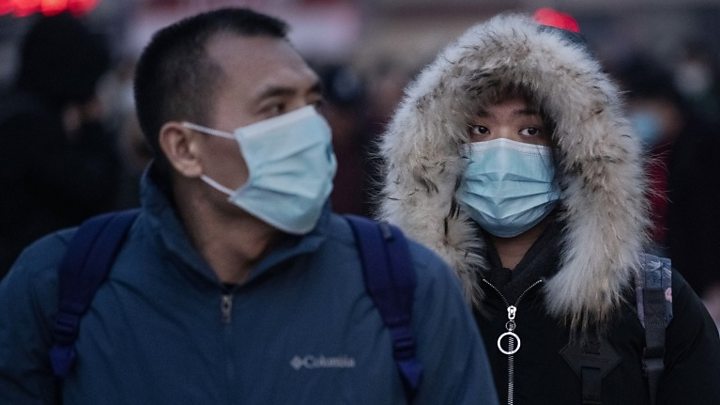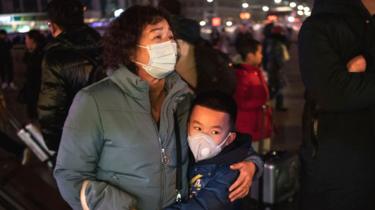Asia
Chinese authorities have urged people to stop travelling in and out of Wuhan, the city at the centre of a new virus outbreak that has killed nine.
Those living in the city of 8.9 million people have also been told to avoid crowds and minimise public gatherings.
The new virus has spread from Wuhan to several Chinese provinces, as well as the US, Thailand and South Korea.
There are 440 confirmed cases, with the origin a seafood market that "conducted illegal transactions of wild animals".
"Basically, do not go to Wuhan. And those in Wuhan please do not leave the city," said National Health Commission vice-minister Li Bin in one of the first public briefings since the beginning of the outbreak.
Authorities also admitted that the country was now at the "most critical stage" of prevention and control.
China earlier this week confirmed that human-to-human transmission of the virus had taken place.
The virus, known also as 2019-nCoV, is understood to be a new strain of coronavirus that has not previously been identified in humans. The Sars virus that killed nearly 800 people globally in the early 2000s was also a coronavirus.
Signs of infection with the new virus include respiratory symptoms, fever, cough, shortness of breath and breathing difficulties.
The first US case was confirmed on Tuesday. President Donald Trump said the situation was "totally under control" and that he trusted the information being provided by Chinese authorities.
What is the latest on the outbreak?

Mr Li said there was evidence that the disease was "mainly transmitted through the respiratory tract". In general, coughs and sneezes are a highly effective way for viruses to spread.
But China has still not been able to confirm the exact source of the virus. "Though the transmission route of the virus is yet to be fully understood, there is a possibility of virus mutation and a risk of further spread of the epidemic," said Mr Li.
- Chinese virus: How worried should we be?
- UK 'to monitor China flights' as virus precaution
- New China virus: Your questions answered
- China drug makers soar on virus contagion fears
He added that there were 2,197 people who were known to have come into contact with infected patients.
No super spreader - a patient who has transmitted the virus to more than 10 people - has been discovered so far.
At least 15 medical workers in Wuhan, who presumably came into contact with patients, are known to be infected.

Wuhan - the heart of the outbreak
 WANG ZHAO
WANG ZHAO
It's not a Chinese mega-city as well known as Beijing or Shanghai, but Wuhan has connections with every part of the globe. Only slightly smaller than London, the city is home to an international airport that handles tens of millions of passengers each year.
These global links explain why the cases of the virus abroad have all involved people either from Wuhan or who had recently visited it.
The city has economic clout too - nearly half of the world's 500 biggest companies have invested there.

How fast is the virus spreading?
There's no way to know but it's likely to be exacerbated by the millions of people across China who are travelling within the country for the Lunar New Year week-long holiday. Thousands are also travelling abroad.
 KEVIN FRAYER
KEVIN FRAYER
Mr Li added that the festival would "increase the risk of the disease spreading and the difficulty of prevention and control".
He said strict measures to control the disease would be put in place, calling for those in Wuhan to "avoid crowds and minimise public gatherings".
These measures include temperature screening for all those leaving Wuhan and improved sterilisation and ventilation at major transport hubs.
A ban on the trade of live poultry and wild animals has also been implemented in the city. State media reports said police were conducting spot checks to make sure this is enforced.
"We already know that the disease originated from a market which conducted illegal transaction of wild animals," said Gao Fu, director of the Chinese Centre for Disease Control and Prevention.
"This might be the cause, so the disease could be on an animal, and then passed on from this animal to a human."
Wuhan's mayor has also called for visitors to stay away from the city if there is no urgent reason to visit.
 GETTY IMAGES
GETTY IMAGES
One of the last major outbreaks in China - the H1N1 pandemic - saw harsh methods employed in an attempt to stem the virus.
In 2009, passengers entering China that were found to have flu-like symptoms were put into isolation for seven days. School children also had their temperature tested and any with a fever were sent home.
Where else have cases been reported?
There have been a handful of global cases: three cases in Thailand, one in Korea, one in Japan, one in Taiwan and one in the US.
On Wednesday, the city of Macau also reported its first confirmed case of the virus. The patient is said to be a businesswoman who had arrived from Wuhan over the weekend.
Authorities in many places, including Australia, Singapore, Hong Kong, Taiwan, the US, Russia and Japan have stepped up screening of air passengers from Wuhan.
The UK is expected to begin screening passengers arriving at London's Heathrow airport from Wuhan.
 GETTY IMAGES
GETTY IMAGES
In Australia, a man who had travelled to Wuhan has been placed in isolation and is undergoing tests.
Are the numbers accurate?
Experts say there could be many cases going undetected, with a report by the MRC Centre for Global Infectious Disease Analysis at Imperial College London suggesting there could be more than 1,700 infections.
However, Mr Fu from the Chinese Centre For Disease Control said the figures predicted by the study were "not in line with what we are seeing in reality".
The World Health Organization (WHO) will on Wednesday consider declaring an international public health emergency over the virus - as it did with swine flu and Ebola.
Such a declaration, if made, will be seen as an urgent call for a co-ordinated international response.

How the virus has spread
- 31 December: China alerts the WHO about a spate of pneumonia-like cases in Wuhan
- 1 January: The seafood/animal market believed to be at the centre of the outbreak is closed
- 9 January: WHO says the infection is caused by a new type of coronavirus
- 11 January: First death confirmed
- 13 January: Virus spreads abroad, with a suspected case in Thailand
- 16 January: A case in Japan is confirmed
- 17 January: Second death - a 69-year-old in Wuhan
- 20 January: Number of cases triples to more than 200, and outbreak spreads to Beijing, Shenzhen and Shanghai; third death confirmed; Chinese officials confirm human-to-human transmission
- 21 January: US authorities announce the first case in North America - a man who had visited Wuhan
- 22 January: Death toll climbs to nine, with more than 400 cases confirmed
BBC news





0 Comments